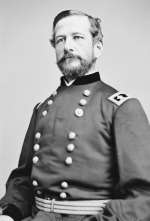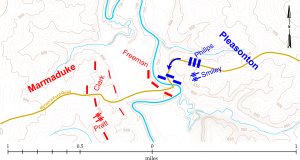Search:
Powered by
Website Baker
Tour Stop, “Federal Attack on Oct 23”
[Waypoint = 39.019018, -94.518879]
Directions
This tour stop is located on the high ground at the eastern end of the Historic Byram’s Ford Road. It’s a short, 200 yard hike of moderate difficulty over uneven ground. You will experience a change in elevation of about 50 feet from the previous tour stop. Continue walking up the Historic Byram’s Ford Road. You’ll know when you reach the end because you’ll be at the top of the hill and there will be one of the thin orange poles.
Looking to the east, you should be able to see the former roadbed of 58th Street. Just to your right (south) is what used to be a cul-de-sac at the end of 58th Street. There used to be a bridge over railroad tracks about one block east of the cul-de-sac. The bridge fell into disrepair and was condemned. The neighborhood houses were purchased by the city of Kansas City because it was cheaper than rebuilding the bridge. The pavement of 58th Street and the houses west of the railroad tracks are no longer there. But you can see that 58th Street in this area followed the route of the Byram's Ford Road.
Description
|
Map of initial Federal attack on October 23, 1864 by theCivilWarMuse based on USGS 1935 Kansas City Quadrangle (Click map for larger image) |
When you get to the top of the hill, turn to look west. Unfortunately, you won’t be able to see what the Federals saw back in 1864. At some point in the future, we hope to open up the view so you can see more of the terrain. There were a lot fewer trees back in 1864. Most of the area around you would have been tall grass prairie. There was a substantial growth of trees along both sides of the Big Blue River and along the creeks flowing into the river. But the Federals positioned on this hill certainly could have seen across the river to the high ground west of the river about three quarters of a mile west of where you are standing.
Up until about 10:30 p.m. on October 22, cavalry forces from Winslow’s Brigade had been fighting with units from Clark’s Brigade in Marmaduke’s Division. The darkness forced the Federals to pull back, allowing the Confederate rear guard to head down the hill and cross at Byram’s Ford to the west side of the river.
The men in Winslow’s Brigade spent the night a little east of your position, catching what sleep they could. At that time of year in 1864, the nights were getting very cold with ice forming on the edges of the creeks and streams. There had been a light snowfall on October 21, so there may still have been a little snow on the ground.
 Sterling Price courtesy of the Library of Congress |
Major General Alfred Pleasonton was keen on pressing the attack. His blood was up because of what he considered a great victory by his cavalry in Independence yesterday. His men had inflicted fairly high casualties on the Confederate rear guard. Pleasonton ordered Brigadier General Egbert G. Brown to take the First Brigade and force a crossing at Byram’s Ford first thing in the morning.
There was just one small problem. The First Brigade was not at the head of the Federal column; Winslow’s Fourth Brigade was. So when they tried to switch positions, everything got all jumbled up. It was 8:00 a.m. or so when Pleasonton realized it was too quiet, so he rode to the front to find out what was going on. He became enraged when he discovered his orders to attack had not been carried out. Pleasonton placed Brown under arrest and sent him to the rear. He then elevated Colonel John F. Philips, Seventh Missouri State Militia Cavalry, to command of the First Brigade and ordered him to “take charge of this entire brigade and go down there and put those people out.” He ordered Colonel Edward F. Winslow to take overall command of the attack and send the Fourth Brigade to attack on the right.
Winslow deployed three guns from Battery H, Second Missouri Light Artillery, just a bit down the hill from where you are standing. Lieutenant Philip Smiley’s 3-inch Ordnance Rifles were easily in easy range of the Confederate positions across the river to the west. But the Federal artillery was also within easy range of the Confederate artillery across the way (a later tour stop).
Historical Vignettes
Colonel John F. Philips, Seventh Missouri State Militia (MSM) Cavalry, wrote in his diary about the confusion on the Byram’s Ford Road first thing on that Sunday morning.
"We were up all night, dragging and sleeping along on our horses and by fires. No feed. Crackers for men, worn out. General Brown ordered to take the advance and attack the enemy at daylight. I took the advance and moved forward at daylight. Trotted up three or four miles. Halted for a few moments on account of Winslow's brigade blocking the road. On again. Came up to the front about 7:30 AM. Dismounted to fight on foot. Was forming line. General Pleasonton came up, was terribly fierce. Pleasonton reprimanded Brown severely for not attacking sooner. Arrested him and sent him to the rear. Put me in command of brigade."
In his official report, Major General Alfred Pleasonton explained why he arrested Brown that Sunday morning.
"Brig. Gen. E. B. Brown was ordered to move his brigade forward and attack the enemy at daylight and keep pushing him vigorously, as he would be well supported. Not finding any attack being made I went to the front. I found Brown's brigade on the road so disordered as to be in no condition for fighting, and General Brown himself had made no preparations to carry out my order. I immediately arrested him, and also Colonel [James] McFerran, of the First Missouri State Militia, whose regiment was straggling all over the country, and he was neglecting to prevent it, and placed Colonel Philips, of the Seventh Missouri State Militia, in command of Brown's brigade."
Captain William C. F. Montgomery, commanding Battery H, Second Missouri Light Artillery, wrote about the Federal artillery used at this location.
"Lieutenant Smiley reported to me with his section, which was immediately sent to the front with Colonel Winslow's cavalry brigade … Next morning at 5 o'clock the battle opened on the Big Blue. Lieutenant Smiley was in action from 8 to 11 a.m. October 23, using canister most of the time."
Captain Richard J. Hinton, commanding the Second Kansas Colored State Militia in the Army of the Border, described the initial Federal attack at Byram’s Ford.
"General [Alfred] Pleasanton … directed Colonel [John F.] Philips, 7th M. S. M., to take command [of the First Brigade]; Lieutenant Colonel [Thomas T.] Crittenden assuming command of the 7th. General [John B.] Sanborn was ordered to support the advance. Colonel [Edward F.] Winslow, by request of General Pleasanton, assumed direction of the advanced movements. The enemy were posted in strong force on the west side of the stream; the ford and approaches being obstructed by Colonel [Charles] Jennison's defenses, materially strengthened by the rebels when they occupied his position. Their line was formed in force about a half mile from the stream. Bearing upon the ford, a heavy gun was planted, by which our line, as it formed and advanced was seriously annoyed, and quite a number killed and wounded."
Colonel Edward F. Winslow’s official report
"Moved about 4 a.m. 23d, driving the enemy over Big Blue, at which stream General [Egbert B.] Brown's brigade was ordered to take the advance and General B. ordered to the rear. At the request of the major-general commanding division I assumed direction of the fighting in front, the enemy being posted on the opposite bank of the river with their main line formed about half a mile from the stream. With one battalion Fourth Iowa Cavalry, 100 Fourth Missouri Cavalry, and one regiment of Brown's brigade, Missouri State Militia, formed on the bank of the stream, the enemy were at once driven to their main line by a vigorous charge."
